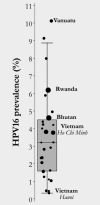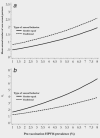Impacts of human papillomavirus vaccination for different populations: A modeling study
- PMID: 29603224
- PMCID: PMC6099330
- DOI: 10.1002/ijc.31409
Impacts of human papillomavirus vaccination for different populations: A modeling study
Abstract
International variations in the prevalence of HPV infection derive from differences in sexual behaviors, which are also a key factor of the basic reproductive number (R0 ) of HPV infection in different populations. R0 affects the strength of herd protection and hence the impact of a vaccination program. Similar vaccination programs may therefore generate different levels of impact depending upon the population's pre-vaccination HPV prevalence. We used IARC's transmission model to estimate (i) the overall effectiveness of vaccination versus no vaccination in women aged 15-34 years measured as percent prevalence reduction (%PR) of HPV16 and (ii) the corresponding herd protection in populations with gender-equal or traditional sexual behavior and with different levels of sexual activity, corresponding to pre-vaccination HPV16 prevalence from 1 to 8% as observed worldwide. Between populations with different levels of gender-equal sexual activity, the highest difference in %PR under girls-only vaccination is observed at 40% coverage (91%PR vs. 48%PR for 1% and 8% pre-vaccination prevalence, respectively). HPV16 elimination is obtained with 55 and 97% coverage, respectively. To achieve desirable levels of HPV16 prevalence after vaccination, different levels of coverage are required in populations with different levels of pre-vaccination HPV16 prevalence, for example, in populations with gender-equal sexual behavior a decrease to 1/1000 HPV16 from pre-vaccination prevalence of 1 and 8% would require coverages of 37 and 96%, respectively. In traditional populations, corresponding coverages would need to be 28 and 93%, respectively. In conclusion, pre-vaccination HPV prevalence strongly influences herd immunity and helps predict the overall effectiveness of HPV vaccination.
Keywords: HPV prevalence; HPV vaccination; coverage threshold; herd effect.
© 2018 International Agency for Research on Cancer (IARC/WHO); licensed by UICC.
Figures




Similar articles
-
Different Challenges in Eliminating HPV16 Compared to Other Types: A Modeling Study.J Infect Dis. 2017 Aug 1;216(3):336-344. doi: 10.1093/infdis/jix299. J Infect Dis. 2017. PMID: 28859431 Free PMC article.
-
Human papillomavirus seroprevalence in pregnant women following gender-neutral and girls-only vaccination programs in Finland: A cross-sectional cohort analysis following a cluster randomized trial.PLoS Med. 2021 Jun 7;18(6):e1003588. doi: 10.1371/journal.pmed.1003588. eCollection 2021 Jun. PLoS Med. 2021. PMID: 34097688 Free PMC article.
-
Assessment of herd effects among women and heterosexual men after girls-only HPV16/18 vaccination in the Netherlands: A repeated cross-sectional study.Int J Cancer. 2019 Jun 1;144(11):2718-2727. doi: 10.1002/ijc.31989. Epub 2018 Dec 21. Int J Cancer. 2019. PMID: 30426502 Free PMC article.
-
Human papillomavirus vaccination and the role of herd effects in future cancer control planning: a review.Expert Rev Vaccines. 2018 May;17(5):395-409. doi: 10.1080/14760584.2018.1471986. Epub 2018 May 21. Expert Rev Vaccines. 2018. PMID: 29715059 Review.
-
Prophylaxis of cervical cancer and related cervical disease: a review of the cost-effectiveness of vaccination against oncogenic HPV types.J Manag Care Pharm. 2010 Apr;16(3):217-30. doi: 10.18553/jmcp.2010.16.3.217. J Manag Care Pharm. 2010. PMID: 20331326 Free PMC article. Review.
Cited by
-
Ambulatory anal self-sampling in MSM living with HIV, an acceptable and reliable screening method.PLoS One. 2021 Feb 9;16(2):e0246338. doi: 10.1371/journal.pone.0246338. eCollection 2021. PLoS One. 2021. PMID: 33561135 Free PMC article.
-
Human papillomavirus vaccine coverage in Rwanda: A population-level analysis by birth cohort.Vaccine. 2020 May 19;38(24):4001-4005. doi: 10.1016/j.vaccine.2020.04.021. Epub 2020 Apr 24. Vaccine. 2020. PMID: 32336599 Free PMC article.
-
Vaccination against HPV: boosting coverage and tackling misinformation.Mol Oncol. 2021 Mar;15(3):770-778. doi: 10.1002/1878-0261.12808. Epub 2020 Oct 15. Mol Oncol. 2021. PMID: 33058497 Free PMC article. Review.
-
Population-level impact of switching to 1-dose human papillomavirus vaccination in high-income countries: examining uncertainties using mathematical modeling.J Natl Cancer Inst Monogr. 2024 Nov 1;2024(67):387-399. doi: 10.1093/jncimonographs/lgae038. J Natl Cancer Inst Monogr. 2024. PMID: 39529531 Free PMC article.
-
Building resilient cervical cancer prevention through gender-neutral HPV vaccination.Elife. 2023 Jul 24;12:e85735. doi: 10.7554/eLife.85735. Elife. 2023. PMID: 37486822 Free PMC article.
References
-
- IARC . Biological agents. IARC Monogr Eval Carcinog Risks Hum. 2012;100B:1–475. Accessed September 12, 2017 at http://monographs.iarc.fr/ENG/Monographs/vol100B/index.php. - PMC - PubMed
-
- Joura EA, Giuliano AR, Iversen OE, et al. A 9‐valent HPV vaccine against infection and intraepithelial neoplasia in women. N Engl J Med. 2015;372:711–23. - PubMed
-
- Lehtinen M, Dillner J. Clinical trials of human papillomavirus vaccines and beyond. Nat Rev Clin Oncol 2013;10:400–10. - PubMed
-
- Crosbie EJ, Einstein MH, Franceschi S, et al. Human papillomavirus and cervical cancer. Lancet 2013;382:889–99. - PubMed
Publication types
MeSH terms
Substances
Grants and funding
LinkOut - more resources
Full Text Sources
Other Literature Sources
Medical
Research Materials

